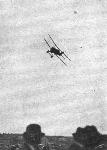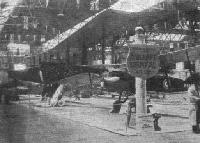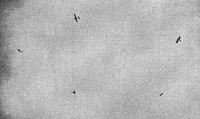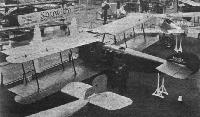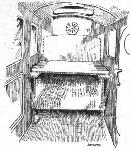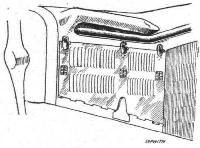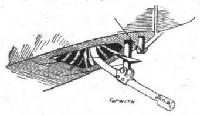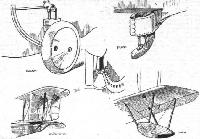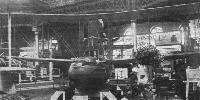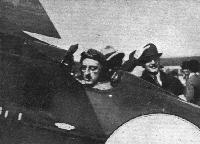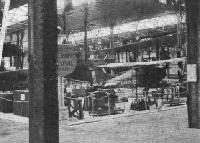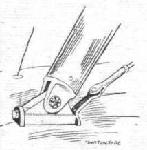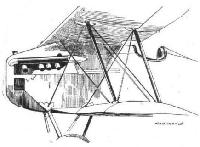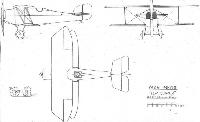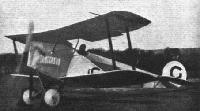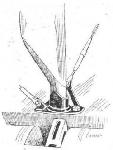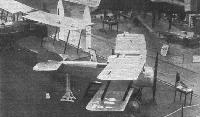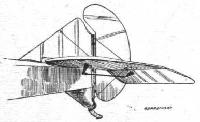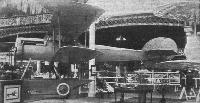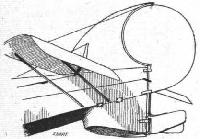Фотографии
-
Two of the Sopwith Snipes completing the first lap in the Aerial Derby. No. 6 leading No. 5 - emphasising the absolute regularity of these fast flyers
Самолёты на фотографии: Sopwith Snipe / 7F.1 - Великобритания - 1918
-
R.A.F. PAGEANT: The R.A.F. mascot views the proceedings from a Snipe
Самолёты на фотографии: Sopwith Snipe / 7F.1 - Великобритания - 1918
-
The Sopwith "Snipe," 200 h.p. B.R.2 (No. 5), flown in the Aerial Derby by Capt. Jordan
Самолёты на фотографии: Sopwith Snipe / 7F.1 - Великобритания - 1918
-
The three Sopwith "Snipes" start for their turn in the Aerial Derby
Самолёты на фотографии: Sopwith Snipe / 7F.1 - Великобритания - 1918
-
The Sopwith "Snipe," 200 h.p. B.R.2 (No. 7), flown by Lieut. Fall in the Aerial Derby
Самолёты на фотографии: Sopwith Snipe / 7F.1 - Великобритания - 1918
-
A SCRAP OVER DOUAI: Colonel W. A. Bishop, V.C., D.S.O., M.C., is flying C.6 with streamer. One of the actual war incidents depicted at Mr. Geoffrey Watson's Exhibition in aid of the R.A.F. Memorial Fund, at the Brook Street Art Gallery, 14, Brook Street, New Bond Street
Самолёты на фотографии: Sopwith Camel / F.1 - Великобритания - 1916
-
AT THE R.A.F. PAGEANT: Flight-Lieut. Noakes, A.F.C., M.M., on "S.E.5b," during his remarkable series of exhibition flights, described by "Contact" as "an exhibition of circus-flying on an 'S.E.5B.' Loops, rolls, spinning nose-dives - all the contents of the aerial bag of tricks were displayed at a height of 1,000 ft., to the accompaniment of gasps from the packed enclosures.''
Самолёты на фотографии: RAF S.E.5 - Великобритания - 1916
-
The Aircraft Disposal Company's Exhibit at the Aero Show, Olympia: A Bristol Fighter and Handley Page Bomber.
Самолёты на фотографии: Bristol F.2A/F.2B Fighter - Великобритания - 1916Handley Page H.P.12 (O/400) - Великобритания - 1917
-
Регистрационный номер: G-EANI The Commercial Mark I.
Самолёты на фотографии: BAT FK-26 Commercial - Великобритания - 1919
-
Side view of the B.A.T. "Commercial"
Самолёты на фотографии: BAT FK-26 Commercial - Великобритания - 1919
-
ON THE B.A.T. COMMERCIAL: Left, the interplane strut attachment; right, the wing|tip skid, and in the centre the undercarriage
Самолёты на фотографии: BAT FK-26 Commercial - Великобритания - 1919
-
THE B.A.T. COMMERCIAL AT OLYMPIA: Diagram showing the arrangement of the formers in the fuselage.
Самолёты на фотографии: BAT FK-26 Commercial - Великобритания - 1919
-
THE B.A.T. FOUR-SEATER COMMERCIAL AT OLYMPIA: 1, Sketch of the pilot's seat and control. 2, Detail of the trimming gear. 3, Diagram of the tail plane trimming gear
Самолёты на фотографии: BAT FK-26 Commercial - Великобритания - 1919
-
Самолёты на фотографии: BAT FK-26 Commercial - Великобритания - 1919
-
A RECORD BREAKER AT OLYMPIA: The Handley Page W 8 which reached an altitude of 14,000 ft. with a load of 3,690 lbs.
Самолёты на фотографии: Handley Page H.P.18 (W.8) / H.P.30 (W.10) - Великобритания - 1919
-
Diagram of the engine mounting of the Handley Page W 8
Самолёты на фотографии: Handley Page H.P.18 (W.8) / H.P.30 (W.10) - Великобритания - 1919
-
The Avro Commercial Triplane at Olympia: This machine has a very comfortable cabin seating four passengers
Самолёты на фотографии: Avro Type 547 - Великобритания - 1920
-
View inside the cabin of the Avro triplane: Near the bottom of the dummy door on the port side are seen the hot and cold air regulators, while in the upholstered back-rest is indicated the little hinged flap which allows of communication with the pilot
Самолёты на фотографии: Avro Type 547 - Великобритания - 1920
-
The aileron balance on the Avro Triplane
Самолёты на фотографии: Avro Type 547 - Великобритания - 1920
-
An Avro interplane strut fitting
Самолёты на фотографии: Avro Type 547 - Великобритания - 1920
-
Самолёты на фотографии: Avro Type 547 - Великобритания - 1920
-
R.A.F. PAGEANT: Event No. 4. A quintette of Bristol Fighters flying in formation "round the mulberry bush"
Самолёты на фотографии: Bristol F.2A/F.2B Fighter - Великобритания - 1916
-
AIR MINISTRY AT THE AERO SHOW: Wireless installation on Bristol Fighter.
Самолёты на фотографии: Bristol F.2A/F.2B Fighter - Великобритания - 1916
-
The Sopwith Antelope at Olympia: In this machine the cabin is entered straight from the ground through a door in the port side
Самолёты на фотографии: Sopwith Antelope - Великобритания - 1920
-
The aft seat in the Sopwith Antelope: The back-rest is hinged, and allows, when resting on the arm-rests of the wicker seat, the passenger to be seated higher, with his head protruding through an opening in the roof
Самолёты на фотографии: Sopwith Antelope - Великобритания - 1920
-
The sliding panel of the Sopwith Antelope is provided with a wind screen for the protection of the passenger when he is seated with his head outside
Самолёты на фотографии: Sopwith Antelope - Великобритания - 1920
-
The engine housing on the Sopwith Antelope is designed with a bonnet like that of a motorcar, the whole side hingeing along the bottom longeron
Самолёты на фотографии: Sopwith Antelope - Великобритания - 1920
-
The steering tail skid of the Sopwith Antelope: The opening in the bottom of the fuselage has an oilcloth cover which prevents dirt from getting into the interior of the body
Самолёты на фотографии: Sopwith Antelope - Великобритания - 1920
-
Самолёты на фотографии: Sopwith Antelope - Великобритания - 1920
-
Регистрационный номер: G-EAOV Three-quarter front view of the Vickers "Viking" amphibious flying-boat, 360 h.p. Rolls-Royce Eagle Engine
Самолёты на фотографии: Vickers Viking / Type 54 - Великобритания - 1919
-
Регистрационный номер: G-EASC The Vickers "Viking" amphibious flying-boat at Olympia
Самолёты на фотографии: Vickers Viking / Type 54 - Великобритания - 1919
-
On the Vickers Viking: Some details of the retractable land undercarriage, combined tailskid and water-rudder, biplane tail, and wing tip float
Самолёты на фотографии: Vickers Viking / Type 54 - Великобритания - 1919
-
The lines of the hull of the Vickers "Viking" are somewhat unusual: The sketch is purely diagrammatic, and should be taken as an approximate representation only
Самолёты на фотографии: Vickers Viking / Type 54 - Великобритания - 1919
-
Самолёты на фотографии: Vickers Viking / Type 54 - Великобритания - 1919
-
Регистрационный номер: K-107 Three-quarter front view of the Vickers-Vimy Commercial
Самолёты на фотографии: Vickers Vimy Commercial - Великобритания - 1919
-
ON THE VICKERS-VIMY-COMMERCIAL: The cabin, showing door to pilots' cockpit
Самолёты на фотографии: Vickers Vimy Commercial - Великобритания - 1919
-
ON THE VICKERS-VIMY-COMMERCIAL: The hinged door which also forms the steps
Самолёты на фотографии: Vickers Vimy Commercial - Великобритания - 1919
-
ON THE VICKERS-VIMY-COMMERCIAL: 1, the extreme aft portion of the fuselage. The terminal cross-tube is used for handling the machine on the ground. 2, the attachment of the tubular tail portion to the fuselage. 3, attachment of girder part of fuselage to aft bulkhead of cabin. 4, detail of longeron lug of 3
Самолёты на фотографии: Vickers Vimy Commercial - Великобритания - 1919
-
Самолёты на фотографии: Vickers Vimy Commercial - Великобритания - 1919
-
A Leitner-Watts Metal Propeller fitted to an Avro
Самолёты на фотографии: Avro Avro 504 - Великобритания - 1913
-
R.A.F. PAGEANT: The Heath Robinson-Avro biplane, funnel, anchor, jazz struts and all, which was such a taxying feature for the crowd. The "Skipper" is just changing into top gear
Самолёты на фотографии: Avro Avro 504 - Великобритания - 1913
-
R.A.F. PAGEANT: Event No. 2. A Martinsyde and a Fokker about to take off for a "scrap," and on the right, the pair in the thick of the fight above the aerodrome
Самолёты на фотографии: Fokker D.VII - Германия - 1917Martinsyde F.3 / F.4 Buzzard - Великобритания - 1918
-
R.A.F. PAGEANT: Event No. 2. Flight Lieut. W. H. Longton, D.F.C., A.F.C., on the Fokker Fighter, and his Charlie Chaplin mascot
Самолёты на фотографии: Fokker D.VII - Германия - 1917
-
At Olympia: The Supermarine Channel Type flying boat
Самолёты на фотографии: A.D. Flying Boat - Великобритания - 1916
-
ON THE SUPERMARINE CHANNEL TYPE: Left, the ingenious boat-hook, and, right, the neat way in which the anchor rope is coiled up on the outside of the hull, thus avoiding getting the cockpit wet and muddy
Самолёты на фотографии: A.D. Flying Boat - Великобритания - 1916
-
SOME SUPERMARINE DETAILS: The wing tip float on the Channel type.
Самолёты на фотографии: A.D. Flying Boat - Великобритания - 1916
-
THE BIPLANE TAIL OF THE SUPERMARINE CHANNEL-TYPE FLYING BOAT: In the Sketch on the left the control cables have been omitted for the sake of clearness. The sketch on the right shows the manner of interconnecting the water-rudder and air-rudders. Here the bracing wires have been omitted
Самолёты на фотографии: A.D. Flying Boat - Великобритания - 1916
-
Самолёты на фотографии: A.D. Flying Boat - Великобритания - 1916
-
The Martinsyde "F.4" (No. 12) passes over Hendon Aerodrome after the first lap for the Aerial Derby
Самолёты на фотографии: Martinsyde F.3 / F.4 Buzzard - Великобритания - 1918
-
The Martinsyde F.4, 300 h.p. Hispano-Suiza (No. 12), piloted by Squadron Leader T. O'B. Hubbard in the Aerial Derby
Самолёты на фотографии: Martinsyde F.3 / F.4 Buzzard - Великобритания - 1918
-
The Martinsyde "Semi-Quaver," 300 h.p. Hispano-Suiza (No. 15), piloted by Mr. F. T. Courtney in the Aerial Derby. This machine won the Derby (fastest time)
Самолёты на фотографии: Martinsyde F.3 / F.4 Buzzard - Великобритания - 1918
-
THE AERIAL DERBY: Mr. F. T. Courtney, the Derby winning pilot, who took Mr. Raynham's place in the 300 Hispano-Suiza-engined Martinsyde "Semi-Quaver.''
Самолёты на фотографии: Martinsyde F.3 / F.4 Buzzard - Великобритания - 1918
-
Регистрационный номер: G-EAPX [2] The Martinsyde "Semi-Quaver" high-speed single-seater scout
Самолёты на фотографии: Martinsyde F.3 / F.4 Buzzard - Великобритания - 1918
-
The Aircraft Disposal Company's Exhibit at the Aero Show, Olympia: Some "parts" and the Martinsyde F 4
Самолёты на фотографии: Martinsyde F.3 / F.4 Buzzard - Великобритания - 1918
-
THE AERIAL DERBY: The "Semi-Quaver" takes off for the race;
Самолёты на фотографии: Avro Baby / Type 534 - Великобритания - 1919Martinsyde F.3 / F.4 Buzzard - Великобритания - 1918
-
Регистрационный номер: G-EAPX [2] A RACER AT OLYMPIA: The Martinsyde "Semiquaver" which will be flown by Raynham in the Aerial Derby
Самолёты на фотографии: Martinsyde F.3 / F.4 Buzzard - Великобритания - 1918
-
SOME MARTINSYDE DETAILS: The interplane strut attachment on the "Semiquaver."
Самолёты на фотографии: Martinsyde F.3 / F.4 Buzzard - Великобритания - 1918
-
The fore part of the beautiful little Martinsyde "Semiquaver"
Самолёты на фотографии: Martinsyde F.3 / F.4 Buzzard - Великобритания - 1918
-
Самолёты на фотографии: Martinsyde F.3 / F.4 Buzzard - Великобритания - 1918
-
THE WINNER OF THE AERIAL DERBY, 1920: The Martinsyde "Semi-Quaver," 300 h.p. Hispano-Suiza engine. Plan, side and front elevations, to scale
Самолёты на фотографии: Martinsyde F.3 / F.4 Buzzard - Великобритания - 1918
-
Регистрационный номер: CH-15 A FLYING BOAT IN VERY STRANGE SURROUNDINGS: A Macchi-Nieuport flying boat, of the Swiss Ad Astra-Aero Co., flying over the Alps
Самолёты на фотографии: Macchi L.1 / L.2 / M.3 / M.4 - Италия - 1915
-
An Avro baby. Type 534, with 35 h.p. Green engine - the actual machine which Mr. Bert Hinkler flew to Turin and back recently
Самолёты на фотографии: Avro Baby / Type 534 - Великобритания - 1919
-
Mr. Hinkler's Avro "Baby," 35 h .p. Green engine (No. 1) in the Aerial Derby
Самолёты на фотографии: Avro Baby / Type 534 - Великобритания - 1919
-
The Avro "Baby," 35 h.p. Green engine (No. 2), flown by Capt. Hamersley in the Aerial Derby. This machine was first in the Handicap
Самолёты на фотографии: Avro Baby / Type 534 - Великобритания - 1919
-
THE AVRO "BABY" AT OLYMPIA: This is the machine on which Mr. Bert Hinkler flew from London to Turin, non-stop, in 9 1/2 hours
Самолёты на фотографии: Avro Baby / Type 534 - Великобритания - 1919
-
Самолёты на фотографии: Avro Baby / Type 534 - Великобритания - 1919
-
The Avro "Schneider," 230 h.p. Siddeley "Puma" (No. 8), flown by Capt. Westgarth-Heslam in the Aerial Derby
Самолёты на фотографии: Avro 539 - Великобритания - 1919
-
The Supermarine "Sea King," a single-seater flying boat
Самолёты на фотографии: Supermarine Sea Lion / Sea King - Великобритания - 1919
-
SOME SUPERMARINE DETAILS: Right, the wing tip float of the "Sea King," and on the left the tail of the "Sea King"
Самолёты на фотографии: Supermarine Sea Lion / Sea King - Великобритания - 1919
-
Самолёты на фотографии: Supermarine Sea Lion / Sea King - Великобритания - 1919
-
Регистрационный номер: F1655 Самолёты на фотографии: BAT FK-22 / FK-23 Bantam - Великобритания - 1917
-
Регистрационный номер: F1661, H-NACH Самолёты на фотографии: BAT FK-22 / FK-23 Bantam - Великобритания - 1917
-
The B.A.T. Bantam at Olympia: The landing wires of the inner bay are attached to the lugs on the side of the fuselage, from which point steel straps run to the top of the bulkhead, connecting the external landing wires to the top spar attachment. Inset is indicated the manner of attaching the top spars to the top of the bulkhead
Самолёты на фотографии: BAT FK-22 / FK-23 Bantam - Великобритания - 1917
-
The B.A.T. Bantam at Olympia: Sketch of the controls
Самолёты на фотографии: BAT FK-22 / FK-23 Bantam - Великобритания - 1917
-
Самолёты на фотографии: BAT FK-22 / FK-23 Bantam - Великобритания - 1917
-
AT OLYMPIA: The Blackburn "Swift" is a torpedo-carrying machine designed for starting from and alighting on the platform of a ship
Самолёты на фотографии: Blackburn Swift T.1 / Dart T.2 - Великобритания - 1920
-
SOME DETAILS OF THE BLACKBURN "SWIFT": On the left the interplane strut attachment In the centre the undercarriage, and on the right the tail skid
Самолёты на фотографии: Blackburn Swift T.1 / Dart T.2 - Великобритания - 1920
-
Самолёты на фотографии: Blackburn Swift T.1 / Dart T.2 - Великобритания - 1920
-
Super Handley Pages as they passed over the Hendon enclosures in formation immediately after rising from the Aerodrome during the R.A.F. Pageant
Самолёты на фотографии: Handley Page H.P.15 (V/1500) - Великобритания - 1918
-
GIANT AT OLYMPIA: The Bristol Pullman triplane with four engines. In spite of its size the Pullman has an extraordinary turn of speed
Самолёты на фотографии: Bristol Braemar / Pullman - Великобритания - 1918
-
The Bristol "Pullman" triplane in flight
Самолёты на фотографии: Bristol Braemar / Pullman - Великобритания - 1918
-
The under-carriage of the Bristol Pullman
Самолёты на фотографии: Bristol Braemar / Pullman - Великобритания - 1918
-
SOME BRISTOL FITTINGS: The sketch on the left show the strut attachments on the Pullman. On the right is seen the tail skid of the Pullman
Самолёты на фотографии: Bristol Braemar / Pullman - Великобритания - 1918
-
The Bristol "Puma" Three-seater Tourer: Showing how the roof of the coupe cabin can be opened up
An unidentified three-seat Tourer with cabin enclosure folded back and port side access ladder.Самолёты на фотографии: Bristol Tourer - Великобритания - 1919
-
THE BRISTOL COUPE TOURER AT OLYMPIA: This machine carries two passengers in addition to the pilot
Самолёты на фотографии: Bristol Tourer - Великобритания - 1919
-
THE BRISTOL COUPE: The body is swelled out in the vicinity of the cabin to give more "elbow room"
Самолёты на фотографии: Bristol Tourer - Великобритания - 1919
-
SOME BRISTOL FITTINGS: The sketch show the strut attachments on the Coupe Tourer.
Самолёты на фотографии: Bristol Tourer - Великобритания - 1919
-
Самолёты на фотографии: Bristol Tourer - Великобритания - 1919
-
The Aircraft Disposal Company's Exhibit at the Aero Show, Olympia: Showing a few fittings and the F 3 flying-boat.
Самолёты на фотографии: Felixstowe F.2 - F.5 - Великобритания - 1917
-
THE FAIREY SEAPLANE AT OLYMPIA: This machine is a military type, designed for fighting. It carries a very complete armament of guns, and the tail is remarkable for the fact that there is no vertical fin above the tail plane
Самолёты на фотографии: Fairey Pintail / Fawn - Великобритания - 1920
-
A "FAIREY TAIL" AT OLYMPIA: There is no fin above the horizontal tail plane
Самолёты на фотографии: Fairey Pintail / Fawn - Великобритания - 1920
-
The Fairey Seaplane XXI: Sketch showing the strut attachment and aileron hinge
Самолёты на фотографии: Fairey Pintail / Fawn - Великобритания - 1920
-
One of the crank levers by which the camber is altered on the Fairey seaplane
Самолёты на фотографии: Fairey Pintail / Fawn - Великобритания - 1920
-
Самолёты на фотографии: Fairey Pintail / Fawn - Великобритания - 1920
-
Регистрационный номер: G-EAFH Avro, type 548, three-seater Tourist biplane. A modification of the standard 504K, with 80 h.p. Renault engine a combination which has several points to commend it from an aerial touring point of view
Самолёты на фотографии: Avro Type 548 - Великобритания - 1919
-
The Avro Tourist at Olympia: The mounting of the Renault engine is very neatly carried out
Самолёты на фотографии: Avro Type 548 - Великобритания - 1919
-
Sketch showing the neat mounting of the Renault engine in the Avro "Tourist"
Самолёты на фотографии: Avro Type 548 - Великобритания - 1919
-
Самолёты на фотографии: Avro Type 548 - Великобритания - 1919
-
The 50 h.p. N. Potez, type VII, Sporting biplane. Note the unusual arrangement of the engine
Самолёты на фотографии: Potez Potez VIII - Франция - 1919
-
Самолёты на фотографии: Potez Potez VIII - Франция - 1919
-
At Olympia: The Short all-metal machine
Самолёты на фотографии: Short Silver Streak - Великобритания - 1920
-
Sketch showing the oleo gear on the Short "Swallow"
Самолёты на фотографии: Short Silver Streak - Великобритания - 1920
-
SOME CONSTRUCTIONAL DETAILS OF THE SHORT "SWALLOW": Reading from left to right the sketches show: The manner of bending the covering of the tail plane over at the edges. The shape of the wings near the root of the ailerons. An interplane strut fitting: note the Short type cable terminal. The extremely neat wing roots of the lower plane
Самолёты на фотографии: Short Silver Streak - Великобритания - 1920
-
Some constructional details of the fuselage of the Short "Swallow"
Самолёты на фотографии: Short Silver Streak - Великобритания - 1920
-
Some features of the tail organs of the show "Swallow"
Самолёты на фотографии: Short Silver Streak - Великобритания - 1920
-
Самолёты на фотографии: Short Silver Streak - Великобритания - 1920
-
Регистрационный номер: G-EAKI [2] The Sopwith A.B.C., 320 h.p. A.B.C. "Dragonfly" (No. 13), piloted by Mr. H. G. Hawker in the Aerial Derby
Самолёты на фотографии: Sopwith Schneider 1919 - Великобритания - 1919
-
Регистрационный номер: G-EAKI [2] Hawker gets away in the Sopwith A.B.C. for the Aerial Derby
Самолёты на фотографии: Sopwith Schneider 1919 - Великобритания - 1919
-
THE SOPWITH "GNU" AT OLYMPIA: The roof of the cabin is hinged along the top, giving access to the interior
Самолёты на фотографии: Sopwith Gnu - Великобритания - 1919
-
External view of the cabin of the Sopwith "Gnu"
Самолёты на фотографии: Sopwith Gnu - Великобритания - 1919
-
Самолёты на фотографии: Sopwith Gnu - Великобритания - 1919
-
Регистрационный номер: G-EARE THE WESTLAND LIMOUSINE: The main petrol tanks are mounted one on each side under the lower plane
Самолёты на фотографии: Westland Limousine - Великобритания - 1919
-
The Westland Limousine, Mark 2, fitted with 300 h.p. Hispano-Suiza engine
Самолёты на фотографии: Westland Limousine - Великобритания - 1919
-
Two views inside the cabin of the Westland Limousine: On the left the two forward seats are shown, and on the right the aft seat and pilot's cockpit
Самолёты на фотографии: Westland Limousine - Великобритания - 1919
-
The petrol tanks of the Westland Limousine are carried under the lower plane, reducing the risk of fire and giving extra space in the fuselage
Самолёты на фотографии: Westland Limousine - Великобритания - 1919
-
An interplane Strut fitting on the Westland Limousine
Самолёты на фотографии: Westland Limousine - Великобритания - 1919
-
Самолёты на фотографии: Westland Limousine - Великобритания - 1919
-
Регистрационный номер: G-EATS The Bristol "Bullet," 450 h.p. Bristol "Jupiter " (No. 14), piloted by Mr. Uwins in the Aerial Derby
Самолёты на фотографии: Bristol Bullet - Великобритания - 1919
-
The Sopwith Dove is a development of the famous Sopwith "Pup."
Самолёты на фотографии: Sopwith Dove - Великобритания - 1919
-
The Sopwith "Dove" sporting two-seater
Самолёты на фотографии: Sopwith Dove - Великобритания - 1919
-
Самолёты на фотографии: Sopwith Dove - Великобритания - 1919
-
The Nieuport "Nieuhawk," 320 h.p. A.B.C. "Dragonfly" (No. 10), piloted by Mr. J. H. James in the Aerial Derby
Самолёты на фотографии: Nieuport & General Nighthawk - Великобритания - 1918
-
The Nieuport "Goshawk," 320 h.p. A.B.C. "Dragonfly" (No. 16), piloted by Mr. Tait-Cox in the Aerial Derby. This machine is the holder of the British speed record of 166.5 m.p.h.
Самолёты на фотографии: Nieuport & General Nighthawk - Великобритания - 1918
-
Самолёты на фотографии: BAT FK-28 Crow - Великобритания - 1919
-
Three-quarter rear view of the B.A.T. "Crow"
Самолёты на фотографии: BAT FK-28 Crow - Великобритания - 1919
-
THE AUSTIN "WHIPPET" AT OLYMPIA: This little machine has folding wings and occupies a very small space
Самолёты на фотографии: Austin Whippet - Великобритания - 1919
-
SOME DETAILS OF THE AUSTIN " WHIPPET." On the left is shown the sprung tail skid, and on the right the body construction. The diagram in the centre shows the wing bracing
Самолёты на фотографии: Austin Whippet - Великобритания - 1919
-
THE AUSTIN "WHIPPET": Left: Sketch showing the locking device for the folding wings. Right: The adjustment of the incidence tube on the Austin "Whippet" is by means of a series of holes
Самолёты на фотографии: Austin Whippet - Великобритания - 1919
-
Самолёты на фотографии: Austin Whippet - Великобритания - 1919
-
Регистрационный номер: G-EARY The Beardmore W.B.II at Olympia. A second machine, the W.B. X, unfortunately, failed to put in an appearance
Самолёты на фотографии: Beardmore W.B.II - Великобритания - 1917
-
THE BEARDMORE W.B.II: The sketch shows the unusual elevator crank lever arrangement and the tail skid
Самолёты на фотографии: Beardmore W.B.II - Великобритания - 1917
-
Beardmore Type W.B.10
Самолёты на фотографии: Beardmore W.B.II - Великобритания - 1917
-
Beardmore Type W.B.II
Самолёты на фотографии: Beardmore W.B.II - Великобритания - 1917
-
Регистрационный номер: G-EAOR Central Aircraft machine. The "Centaur" 4B, three-seater seaplane, a modification of the former type.
Самолёты на фотографии: Central Centaur IV - Великобритания - 1919
-
THE C.A.C. CENTAUR 4B AT OLYMPIA: With an engine of 100 h.p. only this machine gets off the sea very well with three people up
Самолёты на фотографии: Central Centaur IV - Великобритания - 1919
-
The Anzani engine on the C.A.C. Centaur 4B is provided with a starting handle
Самолёты на фотографии: Central Centaur IV - Великобритания - 1919
-
Top: Strut attachment on the Centaur 4B. Bottom: The tail float on the Centaur 4B is mounted on 4 tubes
Самолёты на фотографии: Central Centaur IV - Великобритания - 1919
-
Самолёты на фотографии: Central Centaur IV - Великобритания - 1919
-
THE MARTINSYDE F4A AT OLYMPIA: The four propellers are not mounted on the side of the fuselage to enable the machine to travel sideways, but are on a stand some distance in front of the machine
Самолёты на фотографии: Martinsyde F.4A / F.6 / A - Великобритания - 1919
-
The "Martinsyde "A2" built to carry pilot and four passengers. This view shows the "open cabin" type
Самолёты на фотографии: Martinsyde F.4A / F.6 / A - Великобритания - 1919
-
THE MARTINSYDE CABIN MACHINE, MARK A II AT OLYMPIA: A gauze roof affords ample ventilation of the cabin
Самолёты на фотографии: Martinsyde F.4A / F.6 / A - Великобритания - 1919
-
The Martinsyde F.6, 300 h.p. Hispano-Suiza (No. 11), piloted by Mr. Nisbet in the Aerial Derby
Самолёты на фотографии: Martinsyde F.4A / F.6 / A - Великобритания - 1919
-
Регистрационный номер: G-EAQH Three-quarter rear view of the Martinsyde F4a, two-seater
Самолёты на фотографии: Martinsyde F.4A / F.6 / A - Великобритания - 1919
-
SOME MARTINSYDE DETAILS: The strut attachment on the F4A.
Самолёты на фотографии: Martinsyde F.4A / F.6 / A - Великобритания - 1919
-
Martinsyde A II
Самолёты на фотографии: Martinsyde F.4A / F.6 / A - Великобритания - 1919
-
Martinsyde F.4.A
Самолёты на фотографии: Martinsyde F.4A / F.6 / A - Великобритания - 1919
-
The Short Sporting Seaplane at Olympia
Самолёты на фотографии: Short Shrimp / Sporting Seaplane - Великобритания - 1919
-
The Short Sporting type seaplane, with 160 h.p. Beardmore, which has folding wings
Самолёты на фотографии: Short Shrimp / Sporting Seaplane - Великобритания - 1919
-
The tail planes and tail float of the Short Sporting model: Note the hinged corner of the water-rudder
Самолёты на фотографии: Short Shrimp / Sporting Seaplane - Великобритания - 1919
-
Самолёты на фотографии: Short Shrimp / Sporting Seaplane - Великобритания - 1919
-
DIAGRAM OF THE BREGUET "LEVIATHAN": A, propeller shaft; B, engines; C, clutch; D, radiator; E, oil tank; F, petrol tank; G, turbo-compresser; H, attachment of lower plane; I, passengers' cabin; J, pilot's cockpit; K, wireless cabin; L, water-tight bulkhead; M, adjustable fin; N, fixed fin; O, fixed fins some distance out from centre line; P, rudder; Q, adjustable tail plane; S, elevator; T, tail skid
Самолёты на фотографии: Breguet Br.20 / Br.22 Leviathan - Франция - 1922
-
A Japanese Crash. - Following its crash at the Tokorozawa military aerodrome during the War, when its pilot, Lieut. Sakamoto, was killed, this biplane was propped up in the posture in which it struck the ground, so that the Japanese military authorities might study the accident fully.
Самолёты на фотографии: PMBRA Seishiki-2 - Япония - 1918
-
The Airco 14A 450 h.p. Napier "Lion" (No. 4) flown by Mr. F. S. Cotton in the Aerial Derby
Самолёты на фотографии: De Havilland D.H.14 Okapi - Великобритания - 1919
-
The first Aero Meeting in Czecho-Slovakia was held at Bory, near Plzen (Pilsen) on May 1 and 2 1920, five aeroplanes taking part. The above photograph shows Members of the Committee of the Aero Club of Western Bohemia. Standing in the centre Is Mr. Russ, the Club's "stunt" pilot
Самолёты на фотографии: Aero Ae.01 / A.14 - Чехословакия - 1919
Статьи
- Flight






